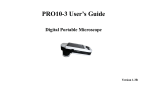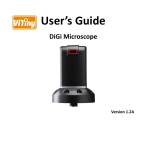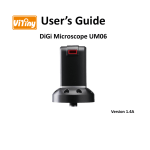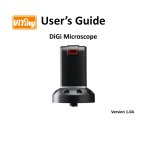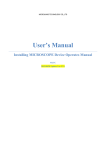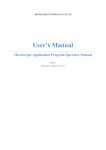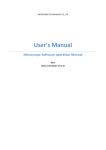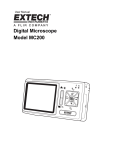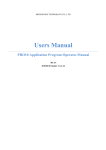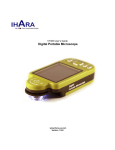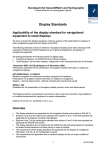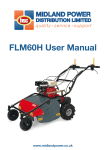Download User Manual of PRO10 Digital Portable Microscope
Transcript
User Manual of PRO10 Digital Portable Microscope Version 2.5A Before using the product, please read the Instruction Manual carefully and keep it appropriately for future reference. Before using the product, please read the Instruction Manual carefully and keep it appropriately for future reference. 4. Contents 1. Products Introduction ...................................... 2 1.1 Packing Contents ........................................ 2 1.2 Functions of Microscope............................. 2 1.3 Operation of Microscope ............................ 4 1.4 Program Functions of Microscope .............. 5 1.5 External Interfaces of Microscope ............ 13 2. Program Installation ...................................... 15 2.1 Insert Installation CD (Step 1) .................. 15 2.2 Install Application Program (Step 2)......... 15 2.3 Install Driver (Step 3) ............................... 15 2.4 Quit Installation Program (Step 4) ............ 16 3. Operate Application Program ........................ 16 3.1 Video Preview Window ............................ 16 3.2 Images Preview Window .......................... 16 3.3 Main Menu ................................................ 16 3.4 Main Button .............................................. 17 3.5 Files List ................................................... 18 3.6 Special Functional Modules ...................... 18 Printed Notice ................................................19 4.1 Maintenance...............................................19 4.2 Product Sizes .............................................19 4.3 Safety Instructions .....................................20 5. Application of PRO10 Supporters ..................20 5.1 Shallow Contact Cap .................................20 5.2 Instruction ..................................................20 Before using the product, please read the Instruction Manual carefully and keep it appropriately for future reference. 1. Product Introduction 1.1 Packing Contents Objects packed inside the box include one host and nine fittings as follows. Please charge the li-ion battery for 6 to 8 hours for the first time. SD Card has been installed inside the host. Please refer to item (4) of Section 1.5 for dismount. Name Qty Name Qty Host of Portable 1 Li-ion Battery 1 Microscope USB 2.0 1 Instruction 1 Transmission Line Manual USB Power Supply 1 Installation CD 1 Device AV Terminal 1 Protection Bag 1 Transmission Line 2G Micro SD Card 1 Wrist Strap 1 Cleaning Cloth 1 on the machine, and press the button again to switch off the machine. (2) Zoom Out : the button is applied to zoom out digital image [please refer to (H) and (I) of item (1) of Section 1.4]. (3) Zoom In : the button is applied to zoom in digital image. (4) RESET Hole: in case that the machine stops (which means no reaction in the image by pressing any button), insert slender clip into the hole to trigger the RESET button. (5) Camera/Video REC : the button is applied to photograph in observing mode [please refer to item (1) of Section 1.4]. Press the button for a long time to enter Comparison mode. In the Video Play mode it can open files [please refer to item (2) of Section 1.4]. In Video REC mode [please refer to item (3) of Section 1.4], the button is used to start record video and stop recording after pressing it again. 1.2 Functions of Microscope Microscope appearance is composed of buttons, transmission and storage interfaces. For the functions of interfaces, please refer to the following contents: (1) Power Supply : press the button for two seconds to switch 2 MicroLinks Technology Co., Ltd. (6) Display Screen: To display image pictures. (7) Function Menu /Delete : after entering observing mode, press the button to skip to the Function Menu ( ). In the mode of browsing photos (Album), press the button to delete photos [please refer to item (4) of Section 1.4]. The button is also used to delete videos in the mode of Video Play. (8) Preview Photos /Back : Press the button to preview photos in observing mode ( ), and back to previous level or exit current image in other models. (9) Charging Display Light : a red lamp to show the charging status if it is on. The lamp is off when the charging is completed [please refer to (G) of item (1) of Section 1.4]. (10) Power Supply Display Lamp : a green lamp to show the machine is switched on. (11) Progressive-Brightness of Lights : brightness can be adjusted at 8 levels [please refer to (D) of item (1) of Section 1.4]. In observing model, the button is used to increase brightness of illumination (auxiliary sources). Press the button for a long time to switch LED mode [please refer to (B) of item (1) of Section 1.4]. Press the button to stop playing in the mode of Video Play. The button is also an optional one for operation in other models. (12) Diminishing-Brightness of Lights : the button is used to decrease brightness of illumination. Press the button for a long time to switch the mode [please refer to ( c ) of item (1) of Section 1.4]. Plus, the button is an optional one for operation in other models. (13) Rotate Lamp Sign Left : rotate left to switch lamp model. Press the button for a long time to display the mark of alignment in range, and press it again to shut down the mark [please refer to (J) of item (1) of Section 1.4]. The button is an optional one for operation in other models. (14) Rotate Lamp Sign Right : rotate right to switch lamp model. Press the button for a long time to display the mark of crossing alignment, and press it again to shut down the mark [please refer to (K) of item (1) of Section 1.4]. The button is used to quickly play video forward in Video Play and optional operation button in other models. (15) Confirmation Button : a switching button of special effects in observing model [please refer to (C) of item (1) of Section 1.4]. Press the button for a long time to display scale, and press it again to shut down the scale [please refer to (L) of item (1) of Section 1.4]. Also, the button is applied to pause in Video Play and confirm in other models. (16) Focus button: a button to adjust optical focus [please refer to item (1) of Section 1.3 and (E) of item (1) of Section 1.4]. (17) Hanging Hole: a hanging hole for the Wrist Strap [please refer to item (6) of Section 1.5]. (18) USB Connection Port: the port is applied to connect USB device to computer [please refer to item (6) of Section 1.4 and item (1) of Section 1.5]. (19) TV Signal Output Socket: the socket is applied to connect to television [please refer to item (5) of Section 1.4 and item (2) of Section 1.5]. 3 MicroLinks Technology Co., Ltd. (20) Lens: the lens is applied to photography. (21) Battery Container: position at which the li-ion battery is placed [please refer to item (5) of Section 1.5]. (22) SD Card Slot: position at which SD Card is placed [please refer to item (4) of Section 1.5 and (F) of item (1) of Section 1.4]. 1.3 Operation of Microscope First, please choose long shot or flush-way shot. Then adjust Focus button. (1) Focus way: the focus is divided into three models composed of L, H and . L means low optical rate (10x), H means High optical rate (40x) and means long shot. Adjust photograph distance (height) to get one to ten times of magnification consecutively. Rotate to left for smaller magnification, and right for larger one. The symbol representing the rate is marked on the button of Focus. In the following image, the button is in the position of 10 times ( ) of magnification. (23) Screw Hole of Rack: the screw hole is applied to fix machine through the rack [please refer to item (7) of Section 1.5]. 4 MicroLinks Technology Co., Ltd. (2) Flush-way: there are only two focuses in flush observation. Adjust Focus dial by turning left for low mag (10x) or turning right for high mag (40x) to observe. Turn left to get smaller mag and right for larger one. Adjust Focus dial to move the symbol of magnification in the middle. Then, slightly adjust the focus to get the clearest image. In the way of flushing, the observed article shall be plat without any concavo or convex. Otherwise, the symbol cannot be placed in the middle, nor the scale can be displayed correctly. Long Shot ( ): Adjust Focus button to move symbol of to the middle position, then slightly adjust it to get the most clear image. After focusing, shoot or photograph as the way of camera. In the long shot, you can choose the mode of camera [please refer to (C) of item (1) of Section 1.4]. 1.4 Program Functions of Microscope There are 8 function modes in the program interface. Press Function Menu /Delete button to switch functional modes in the Camera. In other modes, press the button of Preview Photo /Back to back to the Menu and switch function as displayed in the following image: (3) (1) Camera : Observation mode. Please refer to the above image. represent function modes: 5 Small icons are used to MicroLinks Technology Co., Ltd. Use symbol of to show automatic repetition mode. While starting this mode, press the button or to stop the repetition, and press it again to recover. Also, the repetition will be stopped automatically while pressing any other functional button, and please press button or to restart the repetition. For the light sources and six modes of LEDs, please refer to the following graphics (the black spot means LED position). (A) Current Mode : the machine is in observing mode by graphic of . (B) LED Model : there are 8 white LEDs on the machine for lighting. For the array and corresponding presentations of these LEDs, please refer to the following image. (B-1) Manually switching mode to light one LED (B-2) Manually switching mode to light two LEDs Press the button of for a long time to switch LED signs among 6 modes, and use the buttons of , , and to select. (B-3) Manually switching mode to light LEDs progressively (B-4) Automatic repetition mode to light one LED (B-5) Automatic repetition mode to light two LEDs (B-6) None lamp lights Use to show model of manually swithcing. Press the button of or to switch LED position. 6 MicroLinks Technology Co., Ltd. (C-6) (C) Sceme Mode : Press the button of for a long time to switch among the six scene modes and use the button of , , and to select. : Black mode, for example, the observed articles with dark black. (D) Special Effects : press button to choose the following special effects in observing model: Normal : general model without any special effect. Grey Scale : shows by grey scale to simplify and easily identify images. Reversed-phase : shows by complementary colors to strengthen faint-colored or over-lighted image. (C-1) Relief : Outstanding show the edge and filter out non-marked image. (E) Brightness of Lights : press and to adjust brightness of lights in the observing model. The brightness is divided into the following 8 levels: level 0 (no light) level 4 level 1 level 5 level 2 level 6 level 3 level 7 (most bright) : Automatic mode, which is used as presetting. (C-2) : Camera mode. LED will turn off automatically in this mode. Choose one of the lamp modes again, and the system will set Camera mode as the automatic one. The following four modes can be selected according to brightness of observed article to achieve optimal result. (C-3) : White mode, for example, the observed articles made of shining materials. (C-4) : Grey mode, for example, the observed articles with light colors. (C-5) : Dark Grey mode, for example, the observed articles with dark colors. (F)SD Card Status : the sign of represnets SD card has been inserted into the machine, and means no SD Card inserted. (G) Battery State : the state is divided into three types including Battery in Using, Battery Charging and USB Power Supply. 7 MicroLinks Technology Co., Ltd. Battery in Using : only use battery source without inserting any USB power supply as follows. Full High Medium Low Capacity Capacity Capacity Capacity buttons of zoom out ( ) and zoom in ( ). The magnification is divided into 8 stages and can be up to 4 times with 0.5 times per stage. The image can be enlarged to fifty times after adding optical and digital magnifications. The rates at different stage are as follows: 10x optical rate [10* (1+0.5*stage)] Stage 1 2 3 4 Rate 15x 20x 25x 30x Stage 5 6 7 8 Rate 35x 40x 45 50x Adjust optical magnification to 40 times, and the total magnification can be 200 times after adding digital one. Rates at different stages are as follows: 40x optical rate [40* (1+0.5*stage)] Stage 1 2 3 4 Rate 60x 80x 100x 120x Stage 5 6 7 8 Rate 140x 160x 180x 200x (I) Digital Magnification Stage: digital magnification rates at different stages are listed as follows: 0 1 2 3 4 5 6 7 8 Battery Charging : use USB power supply to charge the battery as follows. The charging will stop if the battery is full, and only USB power supply will be used. Power supply applied to charging can be provided by USB power supply device or USB connection port of computer. The following images are presented while charging USB Source : the graphic will be presented under two circumstances. One is insert USB power supply without using battery, and the other is insert USB source and use full-charged. (H) Optical Digital Magnification : represents current magnification rate. The optical zooming rate will be changed while adjusting symbols on the Focus dial. Please refer to the following graphic. Long Shot ( ) Low Mag (L) High Mag. (H) Digital magnification rate can be adjusted by the 8 MicroLinks Technology Co., Ltd. Scales of Digital Magnification in 10x and 40x Optical Rates Rate 10x 15x 20x 25x 30x 35x 40x 45x 50x Scale 105 70.5 52.5 42.0 35.0 30.0 26.5 23.5 21.0 Rate 40x 60x 80x 100x 120x 140x 160x 180x 200x Scale 26.5 17.6 13.2 10.6 8.88 7.60 6.52 5.76 5.32 (J) Alignment in Range : press the button of for a long time to display the sign of alignment in range, and press it again to shut down the sign. Use the sign to assist in aligning the observed article. (K) Crossing Alignment : Press the button of for a long time to display the sign of crossing alignment, and press it again to shut down the sign. Use the sign to show the position in which the lens of machine is located and make the alignment more conveniently in observation . (M) Preview mode:To press under preview mode and enter photos browsing. View taken photo in the window. (L) Scale: Press the button of (Confirmation) to display the scale, and press it again to shut down. Press the button of without releasing to select different scales. After selection, release the button. The two types of scales are showed as follows: L-shaped Scale Crossing Scale The series number of the current photo is shown at the left top side. Press button to go next photo. Press button to go previous photo. It can enlarge and shrink the viewing photo by & button. After it enlarges the photo, it can move the photo up 、down、left & right through 、 、 、 button. Press button to return the original window status, then it can allow to swift next photo. (N) Comparison mode:Press button for 10 seconds under preview mode, it can enter Comparison mode. See The scale may be inaccurate because of concaved and convex observed articles making the focusing distance is not at standard position. For the standard focus, please use the flushing-way [Please refer to item (2) of Section 1.3]. The scales will be varied with magnification rates changes. The unit in the scale is 「μm」. The following scales are highly precise and provided for the users as references. 9 MicroLinks Technology Co., Ltd. below illustration, the right window is the latest photo and the left window is the previewed image. All buttons are same functions but only allow to control the left preview window. return the preview photo. Press & move the photo slightly toward left or right. (2) Video Play : Please refer to below following for a description the Video Play mode. Under browsing photo, press for 10 seconds, it can enter Comparison mode. See below illustration. At the moment, all buttons are same function but only allow to control the right window. Press button to swift next photo and press button and (A) Open File : Press the button of (Camera) in the mode of Video Play to enter the interface of file selection. Select the demanded file as in the following image. After selection, press the button of to play. Use buttons and to select items in the interface (such as file type, file slot, file folder and file). Use buttons of and to select options in the interface. (A-1) File Type: including .3gp and.mp4. Choose all means all types of files are selected. (A-2) File Slots including C and D. SD card is inserted into the slot D. (A-3) File Folder means the position in which the file is selected. to 10 MicroLinks Technology Co., Ltd. (A-4) File means to select the file that to be opened. (B) Stop : Press the button of (3) Video REC : a model to record the video, please see the icon on the upper left.: to stop playing video. (C) Play : After selecting file, press the button of (Confirmation) to play the video, and the sign of will be changed to (pause). Press the button of (Confirmation) to pause playing. (D) Last File : Press the button of (E) Hide the Panel control panel. (A) Current Mode from . The users can change Special effect and LED position, adjust brightness and digital magnification during recording. (B) Recording Time: After recording, recording time will be counted in second. Each file can be recorded less than one hour. to hide the (F) Next File : Press the button of to play the next file. (G) Current Time: Total time for the playing/video play currently. (H) Timer Shaft: Timer shaft for video playing. In addition, you can press the button of / to delet the current video, and the button of to quit playing program. representing current video recording. Press the button (video recording) to record, and the Current Mode turns to be to play the last file. : Press the button of : After entering Video REC mode, the mark of Current Mode is showed as (4) Album : a model to browse photos by listing all shot pictures. Please refer to the following image. Use buttons , , and to select images and press the button of 11 MicroLinks Technology Co., Ltd. to open it in full screen. Press the button of to delete the image, and the inquiry window will be displayed before the deletion. Select (Y) for deletion and (N) for not. camera or microscope camera. Before using, please link the USB transmission line and install driving program in the computer for correct linkage. For program installation, please refer to Section 2. The mode is as follows: (5) USB Disk : USB storage mode. Install SD card as USB storage device. For installation of transmission line and linkage, please refer to item (1) of Section 1.5 and the following image. (7) Set Up : a model to set the system and provides five functions for selection according to your own orientation. Please refer to the following setting image. (6) PC Cam : Mode of computer camera (PC Camera). In this mode, the machine can be linked to the computer as internet Press buttons of and 12 , , and to select and adjust to confirm the setting. System will be back to the image MicroLinks Technology Co., Ltd. of system setting model after confirmation. Press button (Return) to quit the model. (A) TV output mode output. : You can choose PAL or NTSC (B) Auto shut down mode :This function can help you shut off the machine after a selected period of inactivity. Or to choose “never” to skip this function. (C) White balance : set white balance automatically for switching on and off. Automatic white balance can correct image’s contrast and color. We suggest you switch on automatic white balance to achieve optimum result. machine including transmission line and SD Card, etc. Do not use other size of accessories, which might cause the machine failed or incompatible with accessories. (1) Connect USB Transmission Line: joints at two ends of USB transmission line are different. Smaller joint is used to connect microscope host, and the larger one is used to connect USB connection port of the Computer. While connecting to computer, power source can also be provided besides transmitting images (PC Camera). Please refer to the following image about connection way of USB transmission line. (D) Status display : Use the button to display the status. The user can set whether to display all status marks in the image. (E) Factory default : Revert to factory default settings. (F) Delete DSC/VID : delete VID stored in SD Card and files in DSC folder. VID is for storing videos, and DSC is for storing photos. (2) Link AV Terminal Transmission Line: please refer to the following image for the linkage. (8) About : the model to check relevant information of the product. Press button (Return) to quit the model. 1.5 External Interfaces of Microscope The machine contains many external interfaces. The following contents give instructions about assembly of the accessories. Please use accessories provided together with the 13 MicroLinks Technology Co., Ltd. The transmission line is applied in TV Out mode. Link smaller joint to the microscope host, and the larger one (yellow) to TV. After linkage, switch to the main menu or Camera mode, the system will output the image to the TV automatically. Watch the screen of the TV to operate or observe. The mode is showed in the following image. (3) Install USB Power Supply Device: provide power supply for the machine by USB transmission line and USB power supply device. Smaller joint is applied to connect microscope host, and the larger one is applied to connect USB power supply device (or USB connection port connecting to computer can also provide power supply). The installation is as follows. (4) Install SD Card: remove battery and the cover, and then push away upper cover of memory card holder. Place SD Card correctly and push the cover back (locking). Place the battery and close the cover. Please turn off the power supply before handling SD Card. Do not conduct hard handling. Please refer to the following image. (5) Install Battery: remove the battery cover and input the battery by placing the written face up and complying with positive and negative poles correctly. Close battery cover finally. Please refer to the following image. 14 MicroLinks Technology Co., Ltd. (6) Install Wrist Strap: Remove battery cover. Hang the wrist strap on the hook, then close the battery cover. Please refer to the following image. 2. Program Installation For detailed program installation, please refer to the Manual set in the Installation CD (User’s Manual\English\Installing PRO10 Device Operates Manual). Programs shall be installed according to the following 4 steps: 2.1 Insert Installation CD (Step 1) Insert Installation CD provided together with the product into CD-ROM Drive. The CD will be read by computer automatically, and the installation window will be displayed: If the computer does not display installation window, please open the Installation CD and select Autorun.ext as illustrated in the following image: (7) Install Rack: there is a screw hole at the bottom of microscope host. Lock screw head of rack into the hole at the bottom of host to fix the machine. Please refer to the following image. If the Installation CD provided together with the product is lost or unknown damaged, please visit http://www.vitiny.com to download installation files. 2.2 Install Application Program (Step 2) Please click and select the position of Step 2. Press button of Install PRO 10 Application Program to install PRO 10 Application Program. 2.3 Install Driver (Step 3) Before install PRO10 driver, please make sure the SPMP3052 driver does not exist in the same PC, if so, please remove SPMP3052 then install PRO10 driver. 15 MicroLinks Technology Co., Ltd. Please click and select the position of Step 3. Press button of Install PRO 10 Driver to install PRO 10 driving program. 2.2 Step 2 2.3 Step 3 2.4 Step 4 2.4 Quit Installation Program (Step 4) After installing Application Program and Driver, please click and select the position of Step 4. Press button of Exit to quit image of program installation. 3. Operate Application Program Operation Instruction of Application Program is composed of 6 parts about primary operation functions. For detailed contents, please refer to the Operation Instruction set in the Installation CD (User’s Manual\English\PRO 10 Application Program Operation Manual). 3.1 Video Preview Window After connecting to microscope camera, the window will show video information images, videos, played files, as well as operations and display of special function modules. 3.2 Images Preview Window The window is applied to display shot images, edit and process images. 3.3 Main Menu The Main Menu of the Application Program contains the following selections: (1) Files: choose open, save and print files. (2) Setting: includes input device, image quality, video information formats, sources and compression, as well as automatic storage, etc. (3) Windows: you can adjust sizes of video information windows and switch to the single window model. (4) Tools: open different files folders, such as BMP, JPG and AVI. Languages and path of files storage can be reproduced to preset values of the system. (5) Languages: five languages including Chinese in complex and simple forms, English, Japanese and Germany are available for selection. 16 MicroLinks Technology Co., Ltd. (6) About: to show the version, copyright and other relevant information about the Application Program. 3.3 Main Menu (3) Save 3.4 Main Button 3.1Video Preview Window (2) Photography : press the button to capture image from Video Information Preview Window. The captured image will be displayed in Images Preview Window. : store images in Images Preview Window. (4) Image Edition /Quit Image Edition : to enter or quit Image Edition function. After entering, tools of image edition are listed below Images Preview Window as follows: 3.2 Image Preview Window (5) Delete Image : press the button to delete image displayed in the preview window. 3.5 Files List 3.4 Main Button Main Button contains more general functions as follows: (1) On-line /Off-line : button of connecting and disconnecting to microscope camera. Video image will be displayed in Video Information Preview Window after connection. (6) Video REC /Stop Video REC : to record or stop recording video. Recorded video information will be displayed in Video Information Preview Window. You can set compressed coding way by clicking and selecting “Set->Video Information Compression” in the Main Menu. The user is suggested install DivX encoder to achieve better compression results and quality. (7) Video Play /Stop Playing : to play or stop playing video. Video information of played files will be displayed in Video Information Preview Window. Playing tools are listed below the preview window as follows: (8) Image Processing /Quit Image Processing : image processing include reversed video, grey scale, black and white, 17 MicroLinks Technology Co., Ltd. edge detection and other basic functions. After entering Image Processing model, tools will be displayed below Images Preview Window as follows: (9) Print Images Window. (10) Quit : print images displayed in Images Preview : close the Application Program. 3.5 Files List Files List is primarily applied to list all current files contained in folders. Select BMP, JPG or AVI to view saved images/videos. 3.6 Special Functional Modules Start Application Program and connect them. Then tools of Special Function Modules will be showed below Video Information Preview Window including comparison, center concentration, image control and measurement as follows: function. Please refer to the following image for tools of the model. (3) Image Control Model : you can take the machine by your left or right hand, adjust image direction of yourself or object, as well as adjusting contrast, brightness and exposure rate of the image. Please refer to the following image for tools of Image Control Model. (4) Measurement Model : the model can be used as rulers and compasses. Further, the model can measure in the dynamic (real-time image) or static (loaded images or frozen image) images, as well as providing various measuring tools. Please refer to the following image for tools of Measurement Model. (1) Comparison Model : observe similarity of compared images through overlapping and half-half comparison. Before using the model, please load the image for application of other functions. For tools of comparison model, please refer to the following image: (2) Center Concentration Model : the model provides 4 different center concentrations including cross, scope, rectangle and circular to aim at shot objects as an auxiliary 18 MicroLinks Technology Co., Ltd. 4. Printed Notice Please read the following information before operate. 4.1 Maintenance Please abide by the following items while storing or using the product: (1) Keep dry: do not place the product in a humid environment. Dry surroundings are helpful to extend the life of the product. (2) Avoid temperature shock: temperature shock will cause internal condensation inside the machine, for example, take the product into a warm room from cold environment. Please put the machine inside the protection bag or handbag in advance to prevent temperature shock, and avoid using the machine in an environment with over-high/low temperature. (3) Avoid collision and drop: the product might go wrong by strong collision, vibration or distortion. (4) Shut down the machine before cutting off the power supply or removing the battery: do not forced cut off the power supply or remove the battery. (5) Do not make face lens against strong light or sunshine for long time: Strong light rays might degrade sensitive elements and generate white stain on the image. (6) Handle SD Card and movable parts carefully: do not force disassemble SD card or squeeze screen, connection lines of power supply and battery cover. Avoid contacting the lens since they are subjected to damage. (7) Machine not in operation: please switch off power supply and remove battery or unplug power cable, and store them in a dry place with excellent ventilation. Do not expose the machine in an environment lower than -5℃ or higher than 50℃. (8) Appropriate storage: while carrying, please put the machine inside the protection bag to prevent it from being damaged because of collision. 4.2 Product Sizes Sensitive Element Lens Auxiliary Source LCD Memory Communication Magnification Joint Li-ion Battery USB Power Supply Device Electric Consumption Size 2 million pixels CMOS High-sensitive Lens Ultra-bright white light LED x 8 2.8” TFT Color LCD 2 G Byte SD Card USB2.0 Compatible; AV Terminal Compatible Optical Zoom 1x~ 10 x (continue) and 40 x; 5 x Digital Zoom DC IN Terminal (mini USB joint) Model: NP-120; Voltage: 3.7 V AC Transformer(Output: DC 5.0/1A Input: AC 100-240V 50/60Hz) 4V/360mA 130(L) ×64(W) ×28 (T) mm Host weighs around 120 grams (160 grams Weight including the battery) Temperature -5℃ ~ 50℃; Humidity-lower than Operation Environment 85% (No Condensation) For any change, please visit http://www.vitiny.com to check information. 19 MicroLinks Technology Co., Ltd. 4.3 Safety Instructions (1) As an electronic product, please do not use the machine in any place in which all electronic products are prohibited or required to shut off electronic products. (2) Please do not make the machine close to water source or wet since it is not waterproof. Avoid electric shock. (3) Do not make the machine close to chemicals, objects with explosive hazard or fire sources. Please switch off the product in gas station. (4) In case that there is foreign body or water inside the machine, or the machine drops off, or the housing is damaged, please switch off power supply and remove battery or power supply device to avoid fire and electric shock. (5) Do not look steadily at auxiliary sources after switching on the host as it is harmful to your eyes. (6) Please use related products provided by original factory for connection. Do not use any product in connection on your own without approval of original factory. (7) If the machine is left unused in a long time, please remove the battery to avoid leakage and erosion of battery electrolyte. (8) Please dispose used battery in a proper way complying with local laws and regulations. Do not discard them in public waste field. (9) Do not disassemble the machine for inspection on your own. For any problem occurred in the machine itself, please switch off the machine and then contact us by e-mail to the following address: [email protected] 5. Application of PRO10 Supporters 5.1 Shallow Contact Cap 5.2 Instruction (1) There is a magnet on the supporter to help attaching onto the lens. (2) When it uses the supporter, the figure of the ruler is inaccurate. 20 MicroLinks Technology Co., Ltd. ViTiny PRO10 Warranty Product Portable Digital Magnifying/Microscope Machine No. Distributor Seal for Confirmation ( Stamp is necessary for validation of the Warranty ) Type Product Serial Number Purchase Date Purchaser Day Month Year TEL Purchaser Address ※Distributor’s seal shall include name of the shop, Email telephone and address※ Please ask the distributor to fill in the name of the shop, address, purchase date and other contents and seal to protect your rights and validate one-year warranty since upon the purchase date. Contents of Warranty: The Warranty is only provided free of charge for faults caused by the manufacturing within one year since upon the purchase date. Non-warranty: 1. Product appearance parts, such as outer frame, panel and knobs, etc (charged spare parts are limited to one year after completing the product manufacturing). 2. Consumption goods of the host itself, such as li-ion battery, LED lights and lens. 3. Product accessories and fittings, such as power supply device, USB transmission lines, AV terminal transmission lines, 2G Micro SD, protection bag and wrist strap, etc. Services caused by any of the following situations in the period of the warranty shall not be provided free of charge: 1. Improper using or self (entrust any other with) disassembly, repair or refitting. 2. Any fault or damaged machine caused by act of god, lightning strike, abnormal voltage or environmental factors, etc. 3. Discrepancy of product serial number, unfilled Warranty, or unreal fill-in, alteration or unidentified Warranty. Any inspection and repair service after the period of warranty will be charged as follows according to the situation: 1. Service fees (including transportation fees) of product inspection. 2. Repair fees. 3. Fees of replaced parts. ViTiny Service Center Tel: 07-657-9551 Fax: 07-657-9561 Address: 10 F., No.1, Section 1, Syuecheng Road, Dashu District, Kaohsiung City 840, Taiwan (R.O.C.) Website: http://www.vitiny.com HTTP://WWW.VITINY.COM © 2011 MicroLinks Technology Corp. All rights reserved.


























